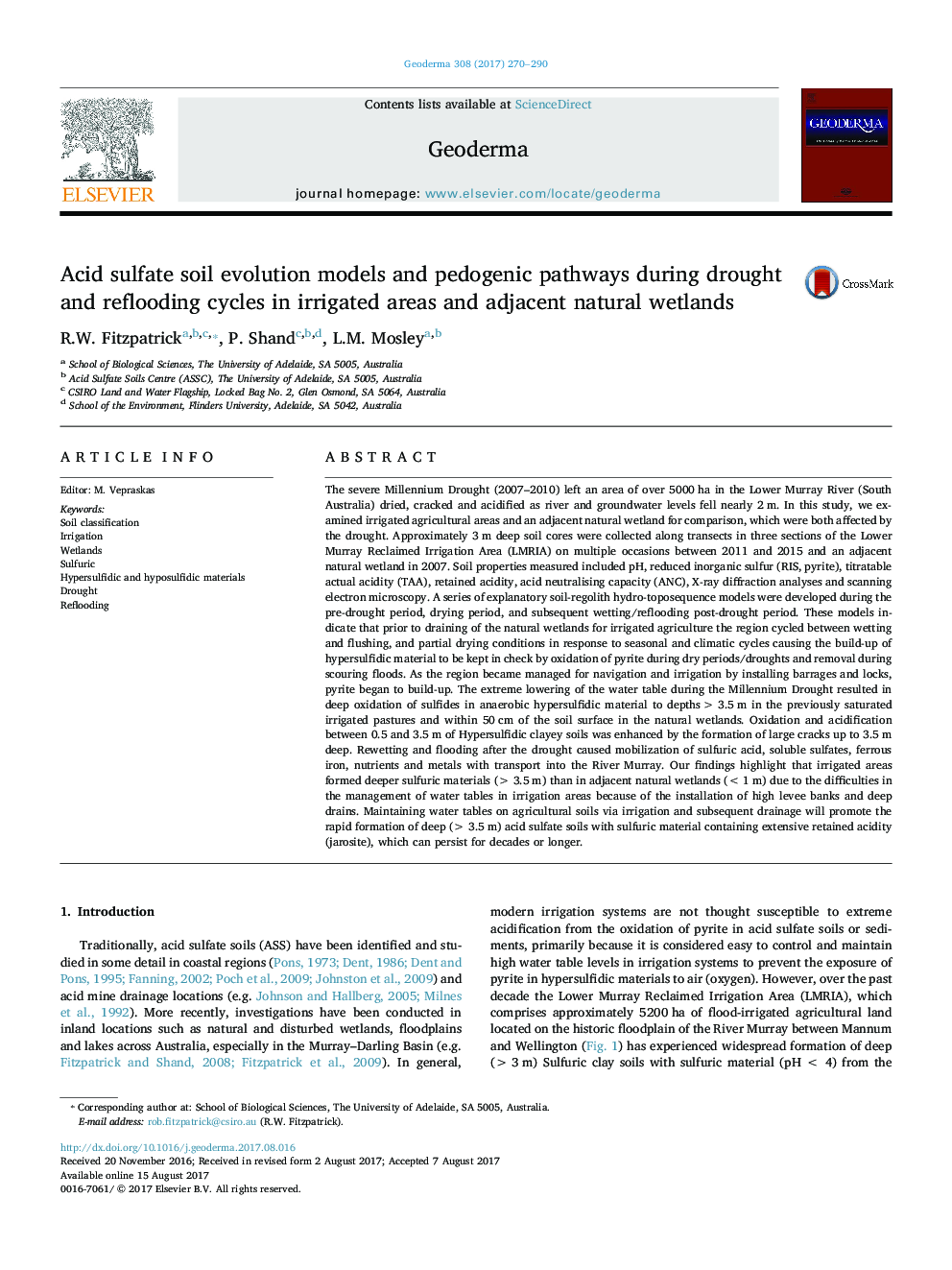| کد مقاله | کد نشریه | سال انتشار | مقاله انگلیسی | نسخه تمام متن |
|---|---|---|---|---|
| 5770570 | 1629409 | 2017 | 21 صفحه PDF | دانلود رایگان |
- Soil-hydro-toposequence models were constructed for irrigated pastures and wetlands
- Models describe and compare major changes in acid sulfate soil subtypes and features
- Drought/drying and flooding/rewetting cycles drove key changes in soil properties
- Sulfuric soils in irrigated areas (>Â 3.5m) are deeper than in natural wetland (<Â 1m) due to management of water table management via levee bank/drain installation.
The severe Millennium Drought (2007-2010) left an area of over 5000Â ha in the Lower Murray River (South Australia) dried, cracked and acidified as river and groundwater levels fell nearly 2Â m. In this study, we examined irrigated agricultural areas and an adjacent natural wetland for comparison, which were both affected by the drought. Approximately 3Â m deep soil cores were collected along transects in three sections of the Lower Murray Reclaimed Irrigation Area (LMRIA) on multiple occasions between 2011 and 2015 and an adjacent natural wetland in 2007. Soil properties measured included pH, reduced inorganic sulfur (RIS, pyrite), titratable actual acidity (TAA), retained acidity, acid neutralising capacity (ANC), X-ray diffraction analyses and scanning electron microscopy. A series of explanatory soil-regolith hydro-toposequence models were developed during the pre-drought period, drying period, and subsequent wetting/reflooding post-drought period. These models indicate that prior to draining of the natural wetlands for irrigated agriculture the region cycled between wetting and flushing, and partial drying conditions in response to seasonal and climatic cycles causing the build-up of hypersulfidic material to be kept in check by oxidation of pyrite during dry periods/droughts and removal during scouring floods. As the region became managed for navigation and irrigation by installing barrages and locks, pyrite began to build-up. The extreme lowering of the water table during the Millennium Drought resulted in deep oxidation of sulfides in anaerobic hypersulfidic material to depths >Â 3.5Â m in the previously saturated irrigated pastures and within 50Â cm of the soil surface in the natural wetlands. Oxidation and acidification between 0.5 and 3.5Â m of Hypersulfidic clayey soils was enhanced by the formation of large cracks up to 3.5Â m deep. Rewetting and flooding after the drought caused mobilization of sulfuric acid, soluble sulfates, ferrous iron, nutrients and metals with transport into the River Murray. Our findings highlight that irrigated areas formed deeper sulfuric materials (>Â 3.5Â m) than in adjacent natural wetlands (<Â 1Â m) due to the difficulties in the management of water tables in irrigation areas because of the installation of high levee banks and deep drains. Maintaining water tables on agricultural soils via irrigation and subsequent drainage will promote the rapid formation of deep (>Â 3.5Â m) acid sulfate soils with sulfuric material containing extensive retained acidity (jarosite), which can persist for decades or longer.
Journal: Geoderma - Volume 308, 15 December 2017, Pages 270-290
